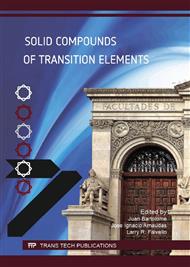[1]
T.B. Massalski (Editor-in-Chief), Binary Alloy Phase Diagrams, Second Edition Plus Updates, ASM International, ASM CD-ROM, Ohio, USA (1996).
DOI: 10.1002/adma.19910031215
Google Scholar
[2]
K. Takahashi and S. Kunii. Single crystal growth and properties of incongruently meting TbB6, DyB6, HoB6, and YB6, J. Solid State Chem. 133 (1997) 198-200.
DOI: 10.1006/jssc.1997.7427
Google Scholar
[3]
M.E. Schlesinger. The lesser-known B-Ln (Boron-Lanthanide) systems: B-Dy (Boron-Dysprosium), B-Ho (Boron-Holmium), B-Lu (Boron-Lutetium), B-Pr (Boron-Praseodymium), B-Tm (Boron-Thulium), and B-Yb (Boron-Ytterbium), J. Phase Equil. 19 (1) (1998).
DOI: 10.1361/105497198770342742
Google Scholar
[4]
P. Alekseev, G. Grechnev, N. Shitsevalova, K. Siemensmeyer, N. Sluchanko, O. Zogal and K. Flachbart. Rare-Earth dodecaborides magnetism, superconductivity and other properties. In: Rare Earths: Research and Applications, ed. by N. Delfrey (Commack, NY: NOVA Sci. Publ. 2008), Ch. 2, pp.79-125.
Google Scholar
[5]
L.C. McGrath, Diss. New Mexico State Univ. (1972), p.1/236, 161/2 (From Diss. Abstr. Intern. B 33 (1972) 2546/7).
Google Scholar
[6]
G.V. Samsonov, L.N. Okhremchuk, I.A. Podchernjaeva, V.S. Fomenko and V.V. Odintsov, Thermoemission of transition metal dodecaborides, Izv. AN SSSR, Neorg. Mater. 10 (2) (1974) 270-272 (in Russian).
Google Scholar
[7]
A. Taran, D. Voronovich, N. Shitsevalova, A. Levchenko, V. Filipov and S. Abashin. Phase transformations in lutetium borides at heating in vacuum, Solid State Phen. 464 (2011) 172-174.
DOI: 10.4028/www.scientific.net/ssp.172-174.464
Google Scholar
[8]
D.A. Voronovich, A.A. Taran, N. Yu. Shitsevalova, G.V. Levchenko, V.B. Filipov. Spectral emissivity (λ = 0, 65 µm) of lutetium boride single crystals, Aerospace Technic and Technology 4 (81) (2011) 80-86 (in Russian).
Google Scholar
[9]
Daniel Voronovich, Anatoliy Taran, Natalya Shitsevalova, Anna Levchenko, Volodymyr Filipov. Anisotropy of the erbium dodecaboride thermionic properties, Solid State Sci. 14 (2012) 1624-1628.
DOI: 10.1016/j.solidstatesciences.2012.04.009
Google Scholar


